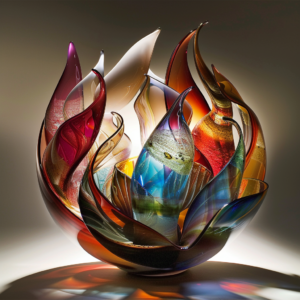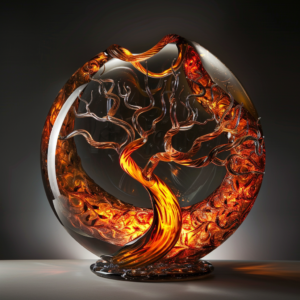Glass sculptures, with their captivating blend of light, form, and color, have long held a place of fascination in the realm of art. These translucent masterpieces, born from the fusion of molten glass and human artistry, possess an ethereal quality that captivates the senses and ignites the imagination. From delicate figurines to monumental installations, glass sculptures adorn homes, galleries, and public spaces worldwide, adding a touch of elegance and enchantment to their surroundings.
A Symphony of Light and Form
Glass sculptures possess a unique ability to interact with light, transforming it into a tangible element of their artistic expression. As light dances through the translucent material, it casts mesmerizing shadows, reflects vibrant hues, and creates an interplay of illumination that adds depth and dimension to the sculpture. This dynamic interplay of light and form is a defining characteristic of glass art, setting it apart from other sculptural mediums.
Unveiling the Enchanting World of Translucent Art
Delving into the world of glass sculptures reveals a vast and diverse landscape of artistic expression. From the delicate intricacies of miniature figurines to the awe-inspiring grandeur of large-scale installations, glass sculptors explore a wide range of themes, styles, and techniques. Whether inspired by the natural world, the human form, or abstract concepts, glass sculptures offer a boundless canvas for creativity.
The Allure of Glass Sculptures
The allure of glass sculptures lies in their ability to evoke a sense of wonder and enchantment. Their translucent nature lends an ethereal quality, transforming them into objects that seem to defy the laws of physics. Light dances through their surfaces, casting shimmering reflections and creating an interplay of shadows that adds depth and dimension. This captivating interplay of light and form draws viewers in, inviting them to explore the intricacies of the sculpture and the artistry that brought it to life.
Beyond Imagination
Glass sculptures have the power to transport us beyond the realm of the ordinary, into a world where imagination reigns supreme. They challenge our perceptions of reality, inviting us to see familiar forms in new and unexpected ways. The fluidity of molten glass allows sculptors to create intricate details and delicate forms that would be impossible in other mediums, pushing the boundaries of artistic expression.
Conclusion
Glass sculptures, with their enchanting blend of light, form, and color, offer a glimpse into the boundless realm of artistic expression. Their ability to captivate the senses, ignite the imagination, and challenge our perceptions of reality makes them a truly unique and captivating art form. As we continue to explore the ever-evolving world of glass sculpture, we are sure to be amazed and inspired by the creativity and artistry that these translucent masterpieces embody.
Call to Action
Delve deeper into the enchanting world of glass sculptures by visiting your local art gallery or museum. Explore the diverse range of styles, techniques, and themes on display, and let your imagination soar as you appreciate the beauty and artistry of these translucent masterpieces.
Frequently Asked Questions
Q: What are some of the different types of glass sculptures?
A: Glass sculptures come in a wide variety of shapes, sizes, and styles. Some common types include:
- Figurative sculptures: These sculptures represent the human form or other living creatures.
- Abstract sculptures: These sculptures do not represent any specific object or figure.
- Functional sculptures: These sculptures have a practical purpose in addition to their aesthetic appeal.
- Installations: These sculptures are large-scale works that are often site-specific.
Q: How are glass sculptures made?
A: Glass sculptures are made using a variety of techniques, including:
- Glassblowing: This technique involves blowing molten glass into a bubble and then shaping it with tools and hand manipulation.
- Casting: This technique involves pouring molten glass into a mold and then allowing it to cool and solidify.
- Fusing: This technique involves layering different pieces of glass together and then heating them until they fuse together.
- Kiln firing: This technique involves placing glass sculptures in a kiln and heating them to a specific temperature.
Q: How can I care for my glass sculptures?
A: Glass sculptures are generally delicate and should be handled with care. Here are some tips for caring for your glass sculptures:
- Handle them with clean, dry hands.
- Avoid exposing them to extreme temperatures or sudden changes in temperature.
- Clean them with a soft, damp cloth.
- Avoid using harsh chemicals or abrasive cleaners.
- Store them in a safe place where they will not be bumped or knocked over.



